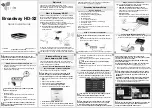
fm
G
enie
fm
G
enie
29
4
User Operating Guide – Receiver
28
fm
G
enie
fm
G
enie
User Operating Guide – Receiver
4
USING AN fmGENIE AND A NECK LOOP WITH
A HEARING AID ON ‘T’ OR HEADPHONES
As already mentioned, you need to switch the hearing
aid to the loop programme in order to pick up the
signal from the neck loop. So what is connected to
what? The
output connects to a neck loop which
generates a magnetic signal which is picked up by
the loop (T) facility on the hearing aid. It’s not
difficult at all – just look at the illustration. The
arrangement is the same whether you wear one or
two hearing aids.
The
should be set to ‘HI’
audio
output for use with neck loops – this
can readily be checked by looking for
the
symbol on the status display. See
below and appendix 3 for more details.
When switched to the loop programme, your hearing aid
microphone is generally turned off, blocking out background
noise and allowing you to focus on the sound
you want to hear. Some people prefer to have
sound from both their loop programme and
their hearing aid microphones combined, so
they can hear their own voice and the voices of
those standing beside them. Your audiologist
will normally be able to programme your
hearing aid in whichever way you prefer.
If you are unable to have your hearing aid
microphones working when switched to the “T”
programme, but still wish to hear sounds around you, you
can plug a lapel microphone into the external microphone
input on the fm Genie receiver .
USING AN fmGENIE WITH A HEARING AID
VIA A DIRECT INPUT CONNECTION
What is connected to what?
The output of the receiver
connects to a lead
which connects to the specific hearing aid
connecting shoe which connects to the
hearing aid! (see illustration).
If you wear one hearing aid you will require
a single lead (pt.no. FMGS). If you wear two
hearing aids you will need a lead with 2 ends
known as a ‘V’ lead (pt.no. FMGV).
The 3 pin plug on the end of the lead is referred to as
a ‘europlug’ connection.
Direct input hearing aid connection gives a better frequency response than
The
direct input hearings aids – this can readily
be checked by looking for the
the status display. See below and appendix
3 for more details.
When using direct input, dependent on
programming, environmental sound can still
be picked up by the hearing aids themselves. As the
environmental microphone facility in the fmGenie
is not
required, simply ensure that the ‘Env vol’ control is turned
down to minimum.
fmGenie receiver and neck loop with a lapel microphone
















































